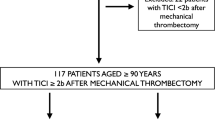Abstract
Deep cerebral venous system thrombosis (DCVST) is a rare variety of cerebral vein and sinus thrombosis (CVST), therefore clinical information regarding presentation, course and outcome are limited. In this two-center study including 32 patients, we tried to better define symptoms, neuroradiological findings, course, and outcome in DCVST. All consecutive patients with DCVST admitted to our two institutions over a period of more than 10 years were identified from prospective registries on CVST and stroke patients. Data from the registries were confirmed and complemented by retrospective analysis of patients’ charts and neuroradiological imaging. Only patients with an unequivocal diagnosis of DCVST confirmed by MRI and MRA were included. Information on long-term functional outcome (modified Rankin Scale, mRS; ability to return to work) was obtained by telephone interviews performed between 2006 and 2008. The clinical presentation was highly variable with headache (81%) and reduced consciousness (72%) as the most frequent symptoms. In nine patients (28%) thrombosis was confined to the deep venous system (isolated DCVST). In the remaining patients other sinuses and/or cortical veins were additionally affected (non-isolated DCVST). Diagnosis was made within one to 76 days (mean = 10.0 ± 14.1 days) but was significantly delayed in patients with isolated compared to non-isolated DCVST (19.1 ± 23.0 vs. 6.3 ± 6.5 days, P = 0.02). Thalamic edema was the most frequent parenchymal MRI finding present in 69% of patients, bilateral in 47%. d-dimer levels were normal in 13% of patients. Most patients (75%) stabilized and later improved on intravenous heparin or subcutaneous low molecular weight heparin. Eight (25%) patients deteriorated with progressing coma; six of them received local endovascular therapy but two died. After a mean follow-up of 3.8 years (range 3 months–13 years), 26 patients (81%) were functionally independent (mRS ≤ 2) including 24 patients (75%) with a mRS ≤ 1 of whom 23 (96%) returned to their previous job, activity or education. No patients were severely disabled (mRS 4–5). Extension of thrombosis beyond the deep venous system had no effect on outcome. Due to its variable clinical presentation the diagnosis of DCVST is often difficult and heparin treatment therefore established with substantial delay. While most patients stabilize and have a good recovery, progressing coma associated with poor outcome is seen in a subset of patients who may thus require other treatment options, such as endovascular therapy.


Similar content being viewed by others
References
Ameri A, Bousser MG (1992) Cerebral venous thrombosis. Neurol Clin 10:87–111
Canhao P, Ferro JM, Lindgren AG, Bousser MG, Stam J, Barinagarrementeria F (2005) Causes and predictors of death in cerebral venous thrombosis. Stroke 36:1720–1725
Ciccone A, Canhao P, Falcao F, Ferro JM, Sterzi R (2004) Thrombolysis for cerebral vein and dural sinus thrombosis. Cochrane Database Syst RevCD003693
Crassard I, Soria C, Tzourio C, Woimant F, Drouet L, Ducros A, Bousser MG (2005) A negative d-dimer assay does not rule out cerebral venous thrombosis: a series of seventy-three patients. Stroke 36:1716–1719
Crawford SC, Digre KB, Palmer CA, Bell DA, Osborn AG (1995) Thrombosis of the deep venous drainage of the brain in adults. Analysis of seven cases with review of the literature. Arch Neurol 52:1101–1108
Einhaupl K, Bousser MG, de Bruijn SF, Ferro JM, Martinelli I, Masuhr F, Stam J (2006) EFNS guideline on the treatment of cerebral venous and sinus thrombosis. Eur J Neurol 13:553–559
Ferro JM, Canhao P, Stam J, Bousser MG, Barinagarrementeria F (2004) Prognosis of cerebral vein and dural sinus thrombosis: results of the International Study on Cerebral Vein and Dural Sinus Thrombosis (ISCVT). Stroke 35:664–670
Frey JL, Muro GJ, McDougall CG, Dean BL, Jahnke HK (1999) Cerebral venous thrombosis: combined intrathrombus rtPA and intravenous heparin. Stroke 30:489–494
Herrmann KA, Sporer B, Yousry TA (2004) Thrombosis of the internal cerebral vein associated with transient unilateral thalamic edema: a case report and review of the literature. AJNR Am J Neuroradiol 25:1351–1355
Horowitz M, Purdy P, Unwin H, Carstens GIII, Greenlee R, Hise J, Kopitnik T, Batjer H, Rollins N, Samson D (1995) Treatment of dural sinus thrombosis using selective catheterization and urokinase. Ann Neurol 38:58–67
Kim SY, Suh JH (1997) Direct endovascular thrombolytic therapy for dural sinus thrombosis: infusion of alteplase. AJNR Am J Neuroradiol 18:639–645
Kosinski CM, Mull M, Schwarz M, Koch B, Biniek R, Schlafer J, Milkereit E, Willmes K, Schiefer J (2004) Do normal d-dimer levels reliably exclude cerebral sinus thrombosis? Stroke 35:2820–2825
Liebetrau M, Mayer TE, Bruning R, Opherk C, Hamann GF (2004) Intra-arterial thrombolysis of complete deep cerebral venous thrombosis. Neurology 63:2444–2445
Newcommon NJ, Green TL, Haley E, Cooke T, Hill MD (2003) Improving the assessment of outcomes in stroke: use of a structured interview to assign grades on the modified Rankin Scale. Stroke 34:377–378
Sagduyu A, Sirin H, Mulayim S, Bademkiran F, Yunten N, Kitis O, Calli C, Dalbasti T, Kumral E (2006) Cerebral cortical and deep venous thrombosis without sinus thrombosis: clinical MRI correlates. Acta Neurol Scand 114:254–260
Terazzi E, Mittino D, Ruda R, Cerrato P, Monaco F, Sciolla R, Grasso E, Leone MA (2005) Cerebral venous thrombosis: a retrospective multicentre study of 48 patients. Neurol Sci 25:311–315
van den Bergh WM, van der Schaaf I, van Gijn J (2005) The spectrum of presentations of venous infarction caused by deep cerebral vein thrombosis. Neurology 65:192–196
Author information
Authors and Affiliations
Corresponding author
Rights and permissions
About this article
Cite this article
Pfefferkorn, T., Crassard, I., Linn, J. et al. Clinical features, course and outcome in deep cerebral venous system thrombosis: an analysis of 32 cases. J Neurol 256, 1839–1845 (2009). https://doi.org/10.1007/s00415-009-5206-3
Received:
Revised:
Accepted:
Published:
Issue Date:
DOI: https://doi.org/10.1007/s00415-009-5206-3




